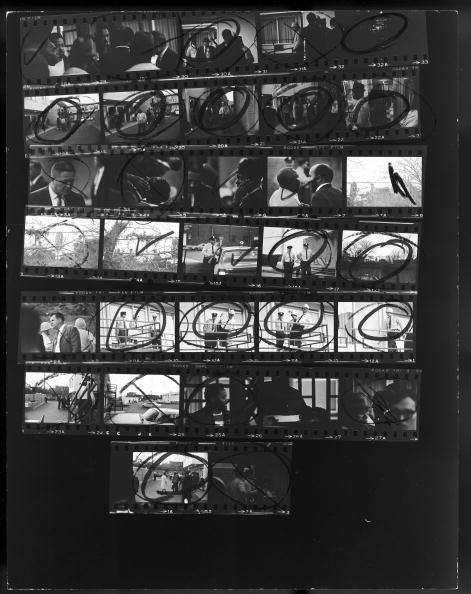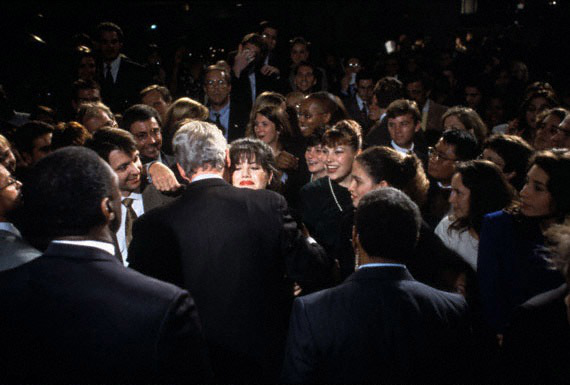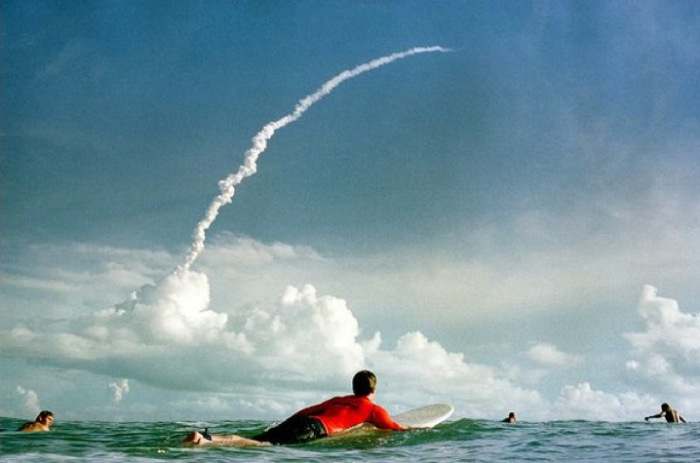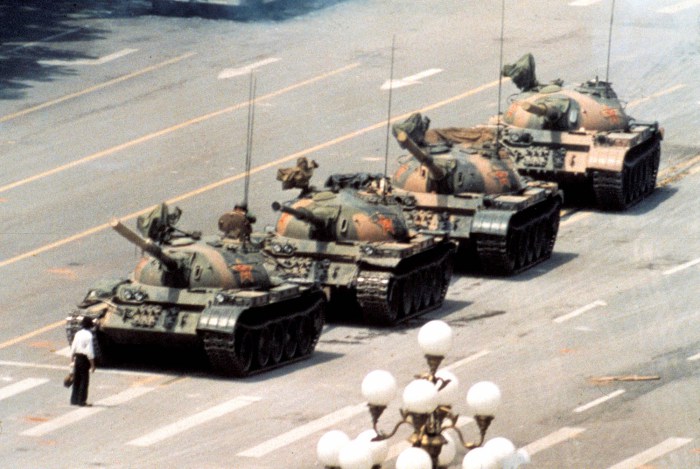Things to Come — Already Arrived
The assassination of Robert F. Kennedy in 1968. Image credit: Bill Eppridge
aNewDomain.net — The restructuring of the Chicago Sun-Times didn’t come as a surprise to anyone in the journalism field (or anyone else, for that matter). The writing was on the wall in early June when the newspaper fired its entire photography staff. The photo department consisted of 28 staffers with “500 years of combined experience,” according to Chicago Tribune photojournalist, Alex Garcia.
Wrapports, LLC is the new owner of the Sun-Times. Its brand of journalism represents how news will be reported, packaged and delivered in the future. The company relies heavily on content providers for its news content. What it’s doing is not new, of course. But it does mark a shift in how news reaches you every morning in your daily newspaper.
Federal agents seize Elian Gonzalez in 2001 from his relatives’ house in Miami. Image credit: Alan Diaz
In May, Wrapports.com announced that it had purchased the Chicago Reader, the area’s iconic alt-weekly newspaper. Years ago I wrote articles for Creative Loafing, a net-based content provider that fed news stories to a variety of newspapers across the country including the Reader. I crafted 500-word media reviews and commentary without ever leaving my apartment in Los Angeles. Those articles popped up in newspapers around the country (like Seattle, Atlanta, and Washington, D.C.) that bought content directly from Creative Loafing.
Back then I didn’t presume to be a journalist making phone calls, requesting interviews, researching, verifying sources or living in the city where my pieces were published. As a commentator, I did not have my finger on the pulse (or my feet on the streets) in these urban areas. But why didn’t newspapers hire local writers to cover their own beats? The reason was simple: it was cheaper to employ a content provider. The writers for Creative Loafing were not paid — and in this way the company was able to sell cheap content to newspapers. As writers, we didn’t see a penny for our efforts. Instead, we were compensated with tear sheets, bylines, clips and experience.
The 1968 assassination of Martin Luther King, Jr. Image credit: Joseph Louw
At the time, just getting my name in print was good enough for me. The bubble had burst in the net world. People had stopped paying fair (and sometimes outrageous) sums of money. It was much easier to put an ad on craigslist.org or writingjobs.com and build a bullpen of writers for free. In the years after the money evaporated from the scene, writers were willing to take whatever gig they could get for a chance to appear in a real newspaper somewhere.
My tear sheets went unread, placed in a file to be shown to a paying publication someday. Until one day I read my Creative Loafing piece in its Atlanta paper.
Aftermath of the Ohio National Guard shootings at Kent State, 1970. Image credit: John Filo
It’s hard to mess with a 500-word article. That’s less text than you’d see on a lot of salad dressing bottles. But it became apparent that the two fellows running Creative Loafing considered themselves editors and felt it crucial that they rearrange everything I’d ever submitted. This was long before SEO optimization and they didn’t adhere to AP Style — this was just their own inexplicable editing style. The Atlanta piece was the end for me and Creative Loafing; I’d reviewed a television program called MTV: Making the Video. The show focused on the video of REM’s hit song, “Man on the Moon.” I didn’t hate the show by any means; it was silly but it had a place on MTV. I merely bemused myself by examining the choices MTV made in what they had presented in this particular 25-minute program. I mocked the pretention of video making (as it had become a new form of movie making), the über celebrity of video stars and famous friends “dropping in,” video-making stunts and props not working, etc … I still love REM and have been a fan of theirs since they were big on the college radio circuit in the late ’80s. I’ve got nothing but love for the band.
Mary Decker’s collision and fall during the 1984 Olympics. Image credit: David Burnett
The “editing” half of the two-man Creative Loafing team did his “magic” on my piece. When I saw the new title of my article I gasped: “REM SELLS OUT.”
This article was sold to the Atlanta Reader. REM is from Georgia. No one who had seen the program or read my review of it could’ve come to that conclusion. And to make matters worse, the editor referred to the video’s director as a man, inexplicably changing my phrasing from “the director” to “him.” He thought he was being really smart and editor-y when in fact he gave a sex change operation to a professional video director. He rewrote a succinct review of a show he had never seen and titled it in an offensive way without regard to the content below the headline. What he actually did was de-edit the piece.
I was sad that my byline wouldn’t be seen in the Creative Loafing client-pubs anymore, but I’d punched my flag in the ground over integrity and quality and it cost me the relationship with its two-man content machine.
President Obama and staff during the mission against Osama bin Laden, 2011. Image credit: Pete Souza
Cut to the Future — Which is Now
It seems like 2013 is going to be a good year for Wrapports and Creative Loafing. I don’t know at what point the Creative Loafing guys went from being clueless consignment operators of other peoples’ work to this version of its entity. But I do know this: Now that a bigger content provider has devoured Creative Loafing, and now that those freelancers are providing content for a trusted publication like the Chicago Sun-Times, the state of journalism appears to be more grim than innovative.
People who don’t write and who have never run a true journalistic effort are now telling photographers that writers with iPhones can do their job. The mandate is now coming from non-journalists who are telling reporters that it doesn’t matter if holes are blasted through their crafted works.
It’s a new era of making writers do another profession on top of their own for no extra money with equipment incapable of handling that task.
President Clinton and Monica Lewinsky before their scandal was revealed in 1998. Image credit: Dirck Halstead
What Bean Counters Don’t Know — But Will Find Out
Bean counters and profiteers don’t understand the limitations of an iPhone. They don’t realize that these mobile devices don’t work quickly or intimately from afar. Nor do these phones produce images in unforgiving light and harsh conditions.
Do they even know how an iPhone works? Have they seen what a camera-phone image looks like if enlarged beyond a 5 x 7-inch print size? They won’t have a tear sheet with a variety of shots to edit because an iPhone can’t recover fast enough to rip successive, clear images. Do the folks at Wrapports understand that the best camera apps require tedious saving of each image before a photographer can relaunch for their next shot?
Viet Cong execution, 1968. Image credit: Eddie Adams
Haven’t the Wrapports people even tried to use an iPhone for their own home pics only to realize that they don’t take sharp, noiseless images in low-light situations? (So much for covering events at night or indoor action.) IPhone tech accessories are clumsy toys that can’t live on board without interrupting other functions you might need. Have they ever seen the image you get with an iPhone telephoto lens?
Have bean-counting content-assassins seen what happens to an iPhone screen when it hits pavement? Do the people at Wrapports know that smartphone batteries can’t be swapped? When the phone battery dies, the user needs to find a laptop or adapter and outlet and leave the device there to recharge. And in the meantime, they better have a backup phone in their holster that’s ready for action. (Here’s a bit of advice: don’t use that flash too much, it’s a big battery zapper!) Has anyone told them that you can fry an egg on an iPhone that’s been cranking all day? Have they seen the incredibly 1980s bad image generated by the iPhone flash?
Space Shuttle Atlantis final launch, 2011. Image credit: Duffin McGee
Do they know that sometimes when you drop an iPhone the micro-sized connections can be dislodged and you lose your monitor even if the glass isn’t broken? Have they hired someone yet with a kit of tiny screwdrivers, extra screen glass, and other repair and maintenance tools? Or will they make their reporters buy their own?
Even bought in bulk, iPhones are too expensive to be disposable.
Do they know that journalists are good at what they do because they master their craft and cultivate stories from current events, local happenings and deep research? Writers foster and weave their stories with information. Photojournalists become specialized in predicting a storytelling moment and using professional, mechanical and electronic gear under seriously distracting or sensitive situations.
Tiananmen Square, 1989. Image credits: Jeff Widener, Arthur Tsang Hin Wah, Terril Jones, Charlie Cole and Stuart Franklin
Photojournalists must remain outside the event they’re covering to be objective even though it’s impossible to be removed from something they are physically near.
Some have suggested that Wrapports made this ghastly, satirical sketch comedy-like move for budgetary concerns. By getting rid of an entire staff of photographers — all with considerable benefits and pensions — it will be able to keep profit margins higher. The resulting deck-clearing saves money by having cheap freelancers and photographic-content providers on the ultra-cheap end of the bottom line.
This is what Wrapports has done. It has created a working environment with no overtime, no benefits, no workers’ compensation, and no life insurance. It’s an organization with no bodies on the ground. Say goodbye to the venerated news corps of photographers; the people with cameras around their necks and years of journalistic experience on their resumes. Because it wants to keep things cheap, Wrapports has sacrificed its news-generating network and the people with news-generating access.
Cluelessly Lying to Themselves
A single image can transform the choices of millions of people; but no Pulitzer Prize will be awarded to a newspaper using photos snapped by a reporter holding a one-note lens 12 inches from his or her face while trying to gather notes to write the story.
The writer and the photojournalist are two critical components of the same profession. They represent a truthful revelation of today’s world in the open press. In this case, the new owners are lying to everyone.
Based in New York, Viki Reed is a senior photographer and pop culture commentator at aNewDomain.net. She’s worked with SubBrilliant News, Anti-Press and Thewax. Check out her work at vikireedphotography.com and email her at Viki@aNewDomain.net or viki@vikireedphotography.com.























